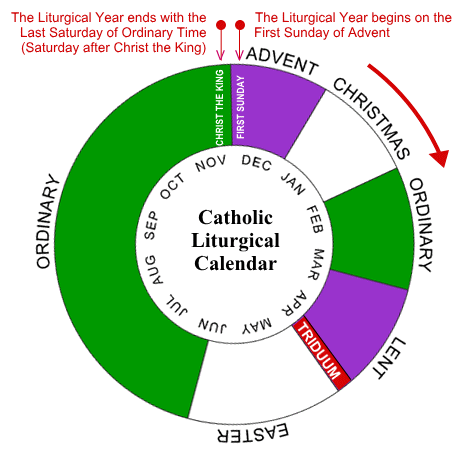The liturgical calendar of the Catholic Church consists of 3 Cycles, A – Matthew, B – Mark, and C – Luke. The liturgical cycle starts at Advent, followed by Christmas, Ordinary times, Lent, Paschal Triduum, Easter and ends at Ordinary times.

Catholic Liturgical Calendar
The liturgical cycle consist of 3 cycles in one.
Cycle A – Matthew, Cycle B – Mark, Cycle C – Luke
These 3 cycles is one liturgical cycle.
Each cycle (A, B and C) begins with the season of Advent and ends with the season of Ordinary times. Each season depicts a different liturgical colour.
Advent – Purple/ Violet
Christmas – White/ Gold/ Silver
Ordinary Times – Green
Lent – Purple/ Violet
Paschal Triduum – Red/ Purple/ White
Easter – White/ Gold/ Silver
Ordinary Times – Green
Advent – Purple/ Violet – Advent always has 4 Sundays. As part of the Advent celebrations the Catholic Church usually prepares an Advent wreath which contains 4 candles (3 purple and 1 rose or pink). At the beginning of each Mass during Advent, a candle is lit. On the 3rd Sunday of Advent, a pink or rose candle is lit. It reflects the halfway mark to the anticipation of the coming of the Christ child at Christmas.
Christmas – White/ Gold/ Silver – Christmas is a celebration of the birth of Jesus Christ. During the season of Christmas we celebrate “The Feast of the Holy Family”, the first Sunday after Christmas. The Feast of the Holy Family is a reflection of God accepting human form in Jesus Christ and living with a human family. The Feast of the Holy Family is a celebration of our own families. White resembles purity and new life.
During Christmas, we celebrate “The Feast of Mary Mother of God”. The Feast of Mary Mother of God is celebrated on the 1st January.
During Christmas we also celebrate “The Epiphany of our Lord”. The Epiphany of our Lord is usually celebrated between the 2nd and 8th of January. The Epiphany of our Lord is a celebration where our Lord is revealed to the world. The Epiphany of our Lord is the day the three wise men (magi) brought gifts of gold, frankincense and myrrh to the baby Jesus.
Ordinary Time – Green – The season of Ordinary times in the Catholic Church is celebrated twice in each liturgical cycle. Ordinary times start after the season of Christmas and ends on Shrove Tuesday (Pancake Tuesday).
Ordinary time is also celebrated after Easter and ends the Saturday after Christ the King.
The season of Ordinary time is a time to grow deeper in our faith. This part of ordinary time is also known as the mystagogia. Mystagogia is getting to a deeper understanding of our Catholic faith. As Catholics, we should use the season of ordinary time to meditate on the Mystery of the Eucharist. We should meditate on the Mystery of the Eucharist on a daily basis. Ordinary time is also a good time to share our faith of the Catholic Church and to meditate on the Mysteries.
Lent – Purple/ Violet – Shrove Tuesday is the day before Ash Wednesday. Ash Wednesday signifies the beginning of Lent. On Ash Wednesday, we are reminded that we are dust and we will return to dust. A cross is marked on our forehead. The mark is ashes. The ashes used on Ash Wednesday are from the palms that has been blessed and burnt from the previous Palm Sunday. The ashes are presented to the priests at a concelebrating Chrism Mass. During Chrism Mass which is celebrated on the morning of the Holy Thursday virgin oil known as Oil of Chrism is also blessed and given to the priests. Oil of Chrism (myrrh) is used during baptism, confirmation, holy orders, anointing of the sick (unction), consecration of churches and confirmation.
Lent continues and ends on Holy Thursday. During Lent we pray the Stations of the cross. Lent symbolises the 40 days of penance and fasting in preparation of Easter.
Paschal Triduum – Purple/ Red/ White (3 days from Holy Thursday to Easter Sunday) – The Paschal Triduum is not traditionally known as a liturgical season but is at the end of the season of Lent and also the beginning of the season of Easter.
Holy Thursday to Good Friday, Good Friday to Easter Saturday, and Easter Saturday to Easter Sunday is known as the Paschal Triduum. The holy week begins on the Monday and ends on Easter Sunday. Palm Sunday is usually included in the Holy Week celebration. Holy week encompasses the Paschal Triduum.
At the Chrism Mass and On Holy Thursday (the last supper) the vestments (stole and chasuble) are white. On Good Friday the vestment of the priest are red. On Easter Saturday the vestment colour is white. On Easter Saturday, the Rights of Christian Initiation of Adults (RCIA) is presented and accepted into the church. The RCIA is a journey which is a reflection of the Emmaus journey where Jesus appeared to two of his disciples talking and lamenting on the crucifixion of Christ.


